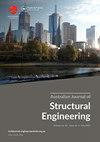纺织钢筋混凝土加固RC梁的非迭代模型分析
IF 1.3
Q4 ENGINEERING, CIVIL
Australian Journal of Structural Engineering
Pub Date : 2021-08-18
DOI:10.1080/13287982.2021.1962618
引用次数: 0
摘要
纺织增强混凝土(TRC)是一种很有前途的增强钢筋混凝土梁的材料,因为它可以定制纺织品和基体,以实现拉伸载荷下的目标应变硬化。考虑到TRC材料特性的复杂性,材料的独立特性对加固后体系的响应影响较大。目前,简单的TRC强化系统的数学预测模型很少。本文的目的是提出一种简化的非迭代方法来预测钢筋混凝土加固梁的性能。利用基于RC和TRC试验数据标定的材料响应,建立了包含两种材料特性和十个无量纲参数的模型。材料参数用TRC的杨氏模量和初裂应变以及各种定义TRC应变硬化、钢的抗拉强度、混凝土的抗压强度和极限应变水平的无量纲参数来描述。准确地考虑了TRC的应变硬化,并对强化后的系统给出了理想的失效准则。用应变值计算某一特定截面的曲率。参数研究表明,材料非线性得到了充分的解决,并预测了强化系统的显著阶段,直到失效。本文章由计算机程序翻译,如有差异,请以英文原文为准。
Non-Iterative Model for Analysis of RC Beams Strengthened with Textile Reinforced Concrete
ABSTRACT Textile reinforced concrete (TRC) is a promising material for strengthening of reinforced concrete beams due to the possibility of customizing both textile and matrix to achieve the targeted strain hardening under tensile load. Considering the complexity involved in material behaviour of TRC, the independent material characteristics majorly influence the response of the strengthened system. Presently, simple mathematical prediction models for TRC strengthened systems are few. The objective of this paper is to propose a simplified non-iterative approach to predict the behavior of RC beams strengthened with TRC. The material response calibrated based on experimental data of RC and TRC is used to develop the model using two material properties and ten non-dimensional parameters. The material parameters are described using Young´s modulus and first-crack strain of TRC in addition to various non-dimensional parameters that define strain hardening of TRC, tensile strength of steel, compressive strength of concrete and ultimate strain levels. The strain hardening of TRC is accurately incorporated, and the appropriate failure criteria for the strengthened system are idealized. Curvature at a particular section is calculated by using strain values. Parametric studies revealed that the material nonlinearity is adequately addressed and salient stages of the strengthened system predicted till failure.
求助全文
通过发布文献求助,成功后即可免费获取论文全文。
去求助
来源期刊

Australian Journal of Structural Engineering
ENGINEERING, CIVIL-
CiteScore
2.50
自引率
0.00%
发文量
31
期刊介绍:
The Australian Journal of Structural Engineering (AJSE) is published under the auspices of the Structural College Board of Engineers Australia. It fulfils part of the Board''s mission for Continuing Professional Development. The journal also offers a means for exchange and interaction of scientific and professional issues and technical developments. The journal is open to members and non-members of Engineers Australia. Original papers on research and development (Technical Papers) and professional matters and achievements (Professional Papers) in all areas relevant to the science, art and practice of structural engineering are considered for possible publication. All papers and technical notes are peer-reviewed. The fundamental criterion for acceptance for publication is the intellectual and professional value of the contribution. Occasionally, papers previously published in essentially the same form elsewhere may be considered for publication. In this case acknowledgement to prior publication must be included in a footnote on page one of the manuscript. These papers are peer-reviewed as new submissions. The length of acceptable contributions typically should not exceed 4,000 to 5,000 word equivalents. Longer manuscripts may be considered at the discretion of the Editor. Technical Notes typically should not exceed about 1,000 word equivalents. Discussions on a Paper or Note published in the AJSE are welcomed. Discussions must address significant matters related to the content of a Paper or Technical Note and may include supplementary and critical comments and questions regarding content.
 求助内容:
求助内容: 应助结果提醒方式:
应助结果提醒方式:


